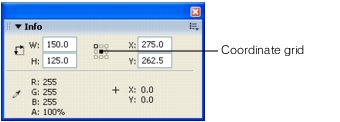

  | |
During a transformation, a transformation point appears at the center of a selected element. The transformation point is initially aligned with the object's center point. You can move the transformation point, and you can return it to its default location.
For scaling, skewing, or rotating graphic objects, groups, and text blocks, the point opposite the point you drag is the point of origin by default. For instances, the transformation point is the point of origin by default. You can move the default point of origin for a transformation.
You can track the location of the transformation point in the Info panel, and in the Property inspector for the graphic object.
 To move the transformation point during a transform operation:
To move the transformation point during a transform operation: To realign the transformation point with the element's center point:
To realign the transformation point with the element's center point: To switch the point of origin for a scale or skew transformation:
To switch the point of origin for a scale or skew transformation: To track the location of the transformation point in the Info panel and Property inspector:
To track the location of the transformation point in the Info panel and Property inspector:The selected square becomes black.
When the center square is selected, the X and Y values to the right of the coordinate grid in the Info panel display the x and y coordinates of the transformation point. In addition, the X and Y values for the transformation point are displayed in the Property inspector for the symbol.

Info panel with center square in coordinate grid selected; x and y coordinates of selection center point displayed
By default, the upper left square in the coordinate grid in the Info panel is selected, and the X and Y values display the location of the upper left corner of the current selection, relative to the upper left corner of the Stage.
Note: For symbol instances, the coordinate grid and the X and Y values display the location of the symbol registration point, or the location of the upper left corner of the symbol instance. See Editing symbols.
  | |